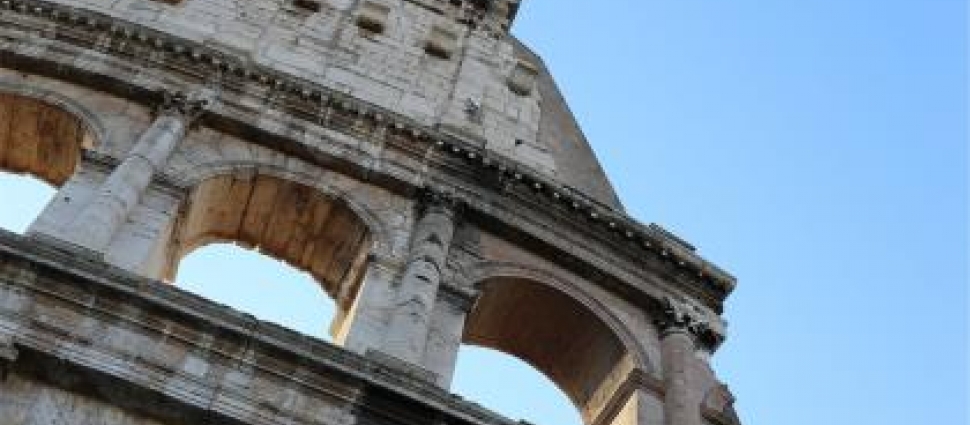Boniface and Leoba

Boniface and Leoba
Some have the impression that, after Constantine’s Edict of Milan in 313, everyone in the Roman Empire became Christian (and lived happily ever after). At least, this is what we might get from a cursor reading of church history.
In reality, as late as the ninth or tenth century, much of the European countryside was still pagan. And even in the areas where Christianity was prevalent, there were lots of diverging ideas. In Ravenna, Italy, for example, visitors can still see next to a Roman Catholic Church a building used in the sixth century for Arian worship.
In this varied and complex world, some Christians felt called to leave their countries to bring the gospel to areas where it was never heard before. The first record of such a commitment is in the Confession of Patrick. A few centuries later, a man known as Boniface took the gospel to the Germans.
A Resolute Missionary
Boniface (or Wynfrith, as he was called at baptism) was born around the year 672 near Exeter, England, probably to a noble family. According to his contemporary biographer Willibald, Boniface showed an intense love for the Scriptures “from the early days of his childhood” and “imitated in particular the practice of the ancient fathers in daily committing to memory the writings of the prophets and apostles, the narratives of the passion of the martyrs and the Gospel teaching of Our Lord”[1] (a habit he kept into his old age).
These tendencies didn’t please Boniface’s father, who wanted him to have a financially rewarding career. Eventually, however, Boniface had his way and joined a monastery as a child oblate. Around 705, after completing his studies, Boniface was ordained priest.
In 716, after much persuasion, he convinced his abbot to allow him and some companions to go on a mission to Frisia (a northern region in today’s Netherlands). There, he immediately met some resistance as the local king, Radbod, equating an acceptance of Christianity with a loss of political independence. After failing to set up churches as planned, Boniface returned to his monastery, only to leave again in 718 – this time for Rome, determined to receive a papal commission.
After testing the young man’s orthodoxy, Pope Gregory II exhorted him “to preach the Word of God to those people who are still bound by the shackles of paganism ... in a spirit of love and moderation, and with arguments suited to their understanding.”[2] That’s when Wynfrith adopted the name Boniface, after a Roman martyr.
Boniface started his missionary work in Thuringia but, after hearing news of Radbod’s death, returned to Frisia to join another missionary from Britain, Willibrord. Older and more experienced, Willibrord was for Boniface an important mentor, teaching him, among other things, how to organize a mission. Later, Boniface moved to region of Hesse-Thuringia, where he worked independently.
In 722, on a new visit to Rome, Boniface was tested again for theological orthodoxy and consecrated bishop. This meant that he could ordain priests. Apparently, he didn’t have difficulties in recruiting other missionaries, both male and female, from Britain. With their help, he evangelized the area and built several monasteries and churches.
Leoba
Of the nuns who joined Boniface, the most famous is one of his relatives named Leoba (born Thrutgeba around the year 700). After inviting her to join him in 746, Boniface appointed her as the abbess of the nunnery of Bischofsheim on the Tauber, where she trained several nuns to take on the same title.
According to her biographer Rudolf (who wrote in the ninth century), Leoba had a great knowledge of the Scriptures, the church fathers, the councils, and ecclesiastical law. He tells how she often asked other nuns to read her the Scriptures at bedtime and, even when to all appearance she was sound asleep, she would always correct them when they misread a word (apparently, they tested her a few times).
At a time when it was common for biographers to enhance their accounts of godly people by recounting spectacular miracles, Leoba’s miracles sounded more ordinary and were accomplished by prayer - from saving a village from a fire and a town from a storm to getting a woman to confess her murder of her unwanted baby (and saving the reputation of her nuns).
Like Boniface, Leoba was influential in the Frankish court. She particularly developed a friendship with Hildegard, Charlemagne’s first wife, who, according to Rudolf, “revered her with a chaste affection and loved her as her own soul. She would have liked her to remain continually at her side so that she might progress in the spiritual life and profit by her words and example. But Leoba detested the life at court like poison.”[3]
While Hildegard was particularly attached to Leoba, according to Rudolf the abbess was sought by many others. “The princes loved her, the nobles received her, the bishops welcomed her with joy. And because of her wide knowledge of the Scriptures and her prudence in counsel they often discussed spiritual matters and ecclesiastical discipline with her. But her deepest concern was the work she had set on foot.”[4]
The Falling of the Tree
Today, Boniface is usually remembered for his challenge to the pagan gods the people in the German region of Thuringia refused to renounce. After counseling with others, he took his axe to their sacred tree, the Oak of Thor. This was not entirely surprising in his day. While not every missionary took up an axe, it was common for Christians to challenge the pagan gods.
Apparently, the local population watched with interest and were finally convinced of the superiority of the Christian God when their gods didn’t react. Boniface built a church where the oak had stood.
While this is the episode most people equate with the ministry of Boniface, Gregory II made no mention of it in a letter he wrote in response to Boniface’s report. Instead, he thanked God for Boniface’s preaching: “As we see that through your obedience the ministry of the Word has succeeded and, as we hear, by your preaching great numbers have been converted to the faith, we give thanks to God that He from whom all good proceeds and whose win it is that all men should be led to recognize the truth, should second your efforts and bring this people by His powerful inspiration from darkness to light.”[5]
Although none of Boniface’s sermons remain, Willibald tells us that he preached in the Frankish language and “those matters that were written for the instruction of the people he paraphrased and explained to them with striking eloquence, shrewdly spicing it with parables. His discretion was such that his rebukes, though sharp, were never lacking in gentleness, while his teaching, though mild, was never lacking in force. Zeal and vigor made him forceful, but gentleness and love made him mild.”[6]
The Last Years of a Fruitful Ministry
In 732, the new pope, Gregory III, made Boniface archbishop (with the power of consecrating bishops). This new title meant that Boniface became busier with the organization of the churches. The following year, however, he decided to return to direct missionary work in Frisia, the land he had long hoped to evangelize. Through his work, thousands were baptized and sacred sites were destroyed and replaced by churches.
His life came to an abrupt end on June 5, 734, when a group of men attacked him and his companions near the Frisian town of Dokkum. We don’t know if these were robbers or if they had specifically targeted the missionaries. In any case, they were frustrated in discovering that the travelers were mainly carrying books. Boniface’s men started to pull out their swords to defend themselves but Boniface told them not to resist. He simply protected his head from the blows of the robbers by holding up a gospel codex. Today, a statue in Dokkum commemorates this moment.
His body, together with those of his companions and some of their books, were carried to the monastery of Fulda, Germany. Almost immediately, he was hailed as a martyr. Today, the Roman Catholic Church celebrates him as the patron saint of Germany.
As for Leoba, after leading her nunnery for twenty-eight years, she retired with a few nuns to Schornsheim, near Mainz, a royal estate Charlemagne had gifted her. She died there on September 28, 782.
In his will, Boniface had requested that she be buried in his own tomb, so they could be raised together at the resurrection. This is not surprising, because they were bound by strong family ties even before their missionary work together, and Leoba regarded him as her own brother. But opening his tomb didn’t seem appropriate fifty years after his death, so she was buried near him in the crypt of the main church at Fulda. A statue in Schornsheim commemorates her life.
[1] Willibald, The Life of Saint Boniface, in Medieval Sourcebook, Fordham University, 3, https://sourcebooks.fordham.edu/basis/willibald-boniface.asp
[2] Gregory II’s Commission of Boniface, Medieval Sourcebook: The Correspondence of St. Boniface, Fordham University, https://sourcebooks.fordham.edu/basis/boniface-letters.asp
[3] Rudolf of Fulda, Life of Leoba, c. 836, in Medieval Sourcebook, Fordham University, https://sourcebooks.fordham.edu/basis/leoba.asp
[4] Ibid.
[5] Gregory II’s Answer to a Report from Boniface (4 December 723), Medieval Sourcebook: The Correspondence of St. Boniface, Fordham University, https://sourcebooks.fordham.edu/basis/boniface-letters.asp
[6] Willibald, The Life of Saint Boniface, in Medieval Sourcebook, Fordham University, 3, https://sourcebooks.fordham.edu/basis/willibald-boniface.asp





